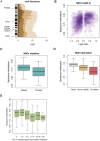Genome-wide CpG island methylation and intergenic demethylation propensities vary among different tumor sites
- PMID: 26464434
- PMCID: PMC4756811
- DOI: 10.1093/nar/gkv1038
Genome-wide CpG island methylation and intergenic demethylation propensities vary among different tumor sites
Abstract
The epigenetic landscape of cancer includes both focal hypermethylation and broader hypomethylation in a genome-wide manner. By means of a comprehensive genomic analysis on 6637 tissues of 21 tumor types, we here show that the degrees of overall methylation in CpG island (CGI) and demethylation in intergenic regions, defined as 'backbone', largely vary among different tumors. Depending on tumor type, both CGI methylation and backbone demethylation are often associated with clinical, epidemiological and biological features such as age, sex, smoking history, anatomic location, histological type and grade, stage, molecular subtype and biological pathways. We found connections between CGI methylation and hypermutability, microsatellite instability, IDH1 mutation, 19p gain and polycomb features, and backbone demethylation with chromosomal instability, NSD1 and TP53 mutations, 5q and 19p loss and long repressive domains. These broad epigenetic patterns add a new dimension to our understanding of tumor biology and its clinical implications.
© The Author(s) 2015. Published by Oxford University Press on behalf of Nucleic Acids Research.
Figures





References
-
- Lee S.T., Xiao Y., Muench M.O., Xiao J., Fomin M.E., Wiencke J.K., Zheng S., Dou X., de Smith A., Chokkalingam A., et al. A global DNA methylation and gene expression analysis of early human B-cell development reveals a demethylation signature and transcription factor network. Nucleic Acids Res. 2012;40:11339–11351. - PMC - PubMed
-
- Rideout W.M. 3rd, Coetzee G.A., Olumi A.F., Jones P.A. 5-Methylcytosine as an endogenous mutagen in the human LDL receptor and p53 genes. Science. 1990;249:1288–1290. - PubMed
-
- Schmutte C., Yang A.S., Nguyen T.T., Beart R.W., Jones P.A. Mechanisms for the involvement of DNA methylation in colon carcinogenesis. Cancer Res. 1996;56:2375–2381. - PubMed
Publication types
MeSH terms
Grants and funding
LinkOut - more resources
Full Text Sources
Other Literature Sources
Research Materials
Miscellaneous

